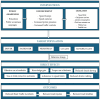Road Fatalities in Children Aged 0-17: Epidemiological Data and Forensic Aspects on a Series of Cases in a Single-Centre in Romania
- PMID: 39334597
- PMCID: PMC11429665
- DOI: 10.3390/children11091065
Road Fatalities in Children Aged 0-17: Epidemiological Data and Forensic Aspects on a Series of Cases in a Single-Centre in Romania
Abstract
Introduction: Road Traffic Accidents (RTAs) are the leading cause of premature death in young people aged 5-29. Globally, 186,300 children aged 9 years and under die from RTAs each year. Romania had the highest mortality rate in children aged 0 to 14 for 2018-2020. This study aimed to assess the involvement of children aged 0-17 years in fatal RTAs by analyzing medico-legal autopsy records in a 5-year period at Timisoara Institute of Legal Medicine (TILM), Romania.
Materials and methods: A retrospective analysis of medico-legal autopsy records of road fatalities in children aged 0-17 years, from TILM in a 5-year period (2017-2021), was conducted.
Results: Of all medico-legal autopsies in the 5-year period, 23 cases (5.8%) involved road fatalities in children aged 17 and under. Preschoolers accounted for 10 cases, followed by the age group 15-17 years (n = 9). Most children sustained fatal injuries as passengers (n = 13), followed by child pedestrians (n = 7). This research follows four representative cases, each being a different type of child road fatality regarding the type of road user, the age of the victim, and the involvement of other risk factors.
Conclusions: Our findings emphasize the tragedy of road fatalities in children and the need to determine risk factors and prevention strategies to reduce the enormous global crisis involving these vulnerable victims.
Keywords: children; medico-legal autopsy; preventive measures; risk factors; road traffic accidents.
Conflict of interest statement
The authors declare no conflicts of interest.
Figures








Similar articles
-
Silent Dangers: The Growing Vulnerability of Older Adults in Fatal Road Traffic Accidents.Cureus. 2025 Mar 17;17(3):e80712. doi: 10.7759/cureus.80712. eCollection 2025 Mar. Cureus. 2025. PMID: 40099308 Free PMC article.
-
Analysis of Road Traffic Accident Fatalities in Karachi, Pakistan: An Autopsy-Based Study.Cureus. 2021 Apr 13;13(4):e14459. doi: 10.7759/cureus.14459. Cureus. 2021. PMID: 33996319 Free PMC article.
-
A retrospective study on the epidemiology and trends of road traffic accidents, fatalities and injuries in three Municipalities of Dar es Salaam Region, Tanzania between 2014-2018.Pan Afr Med J. 2020 May 20;36:24. doi: 10.11604/pamj.2020.36.24.21754. eCollection 2020. Pan Afr Med J. 2020. PMID: 32774601 Free PMC article.
-
Traffic Accidents in Children and Adolescents: A Complex Orthopedic and Medico-Legal Approach.Children (Basel). 2023 Aug 24;10(9):1446. doi: 10.3390/children10091446. Children (Basel). 2023. PMID: 37761407 Free PMC article. Review.
-
[Child-pedestrian injuries inflicted in the road traffic accidents as a forensic medical problem].Sud Med Ekspert. 2017;60(6):13-17. doi: 10.17116/sudmed201760613-17. Sud Med Ekspert. 2017. PMID: 29256479 Review. Russian.
Cited by
-
Silent Dangers: The Growing Vulnerability of Older Adults in Fatal Road Traffic Accidents.Cureus. 2025 Mar 17;17(3):e80712. doi: 10.7759/cureus.80712. eCollection 2025 Mar. Cureus. 2025. PMID: 40099308 Free PMC article.
References
-
- World Health Organization . Global Status Report on Road Safety 2018. World Health Organization; Geneva, Switzerland: 2018. [(accessed on 28 July 2024)]. 403p. Available online: https://iris.who.int/handle/10665/276462.
-
- Global Status Report on Road Safety 2023: Summary. [(accessed on 28 July 2024)]. Available online: https://www.who.int/publications/i/item/9789240086456.
-
- Jackisch J., Sethi D., Mitis F., Szymanski T., Arra I. European Facts and the Global Status Report on Road Safety 2015. WHO; Geneva, Switzerland: 2015.
-
- Zambon F., Sethi D., Racioppi F. European Status Report on Road Safety: Towards Safer Roads and Healthier Transport Choices. WHO Regional Office for Europe; Copenhagen, Denmark: 2009. 161p
LinkOut - more resources
Full Text Sources

